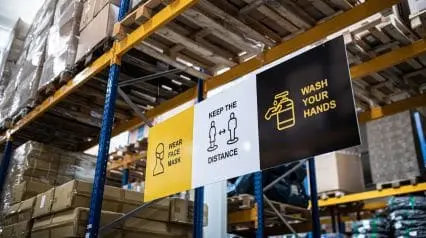What are Warehouse Safety Signs?
Warehouse safety signs are graphical representations of safety information used specifically for warehouses, stockrooms, and similar storage facilities. These universally recognizable visuals are designed to alert workers and visitors about potential hazards and prohibited actions and remind them about safety regulations and procedures. The use of safety signs is mandated by law to prevent accidents and safeguard the health and safety of everyone in the workplace.
Significance
Warehouses are incredibly busy locations filled with workers doing manual handling jobs, palettes of raw materials or finished products, and heavy machinery daily. All these, including the fact that everyone operates on a tight schedule, are ingredients of near misses and accidents. Putting up safety signs is the most proactive way to maintain safety in this incredibly high-risk situation.
- Hazard awareness – Stacked goods on high shelving, constantly moving equipment (e.g., forklifts, pallet jacks, and scissor lifts), and potentially hazardous goods all pose significant risks to workers. These symbols provide must-have information to employees, reminding them to be mindful of their surroundings at all times.
- Prevention of accidents – Clearly communicated safety rules, such as the need to wear Personal Protective Equipment (PPE) or prohibition of particular activities, reinforce safety practices and prevent near misses and accidents, especially in high-risk areas that require extra caution.
- Emergency preparedness – Some of these signs include information that guides employees in emergencies. This includes emergency exits, evacuation routes, assembly points, location of first aid stations, and emergency contact numbers.
Types of Warehouse Safety Signs
Warehouses have unique safety requirements, based on the nature of the operations and specific hazards present in the environment. To effectively address the wide range of risks on-site employees face, here are the four main categories everyone should be knowledgeable about:
Prohibition
These are symbols that either disallow actions or ban specific items within the premises of the warehouse. The sign features graphics inside a red circle that is crossed out with a thick, diagonal red line.
- No entry
- No running
- No smoking
- Do not use mobile phones
- No forklifts allowed
Mandatory
The complete opposite of prohibition signs, mandatory symbols remind individuals of actions or behaviors that must be adhered to for the safety of workers. The symbol typically features a white symbol or text in front of a blue background.
- Hearing and eye protection must be worn
- All cylinders must be chained
- Use handrails and move one step at a time
- Aisle must be kept clear
- Guards must be used
Warning
These warehouse safety signs alert individuals to potential hazards present on site. The high-contrast symbol consists of a black image or text on a yellow background. Note that the exclamation point inside a triangle is a generic caution sign and can be used for various dangers.
- Forklifts in use
- High voltage
- Slippery surface
- Welding in progress
- Pedestrians use other footpaths
Danger signs may be classified under this type since it warns employees or visitors of specific hazards as well. The only difference is that this spells out the whole word with a red background. It often includes additional warnings or instructions at the bottom, such as the following:
- Look out for moving vehicles
- Forklift operating area
- Conveyor may start without warning
Emergency
This category provides critical information that helps workers during emergencies. This features white text or symbols on a green background.
- Exit or evacuation route
- Emergency eye wash
- Emergency phone
- First aid kit
- Fire (smoke) door
Other Warehouse Signs
Several other signs may not be strictly classified under the four mentioned above but provide critical information that workers need to know about the operations in a warehouse.
- Maximum allowable shelf load
- No deliveries from *time*
- Truck drivers must turn off engine, set breaks, set wheel chocks
Compliance
The government plays a critical role in guaranteeing the health and safety of warehouse workers. As aforementioned, the installation of warehouse safety signs is one of the simplest safety precautions that prevent injuries, costly hospitalization, and operational delays. Neglect, deficiency, or outright violation will incur serious sanctions from regulatory bodies.
- OSHA – The Occupational Safety and Health Administration of the United States sets specific requirements for the design, color, and placement of signs under 29 CFR 1910.145.
- HSE – In the United Kingdom, the Health and Safety Executive outlines similar specifications in the Safety Signs and Signals Regulations 1996. This also includes salient information regarding the classification, labeling, and packaging of chemicals.
- Work Safe Australia – Australia’s regulatory details requisites for the design and installation of safety signages in occupational environments in Code of Practice AS 1319-1994.
- EU-OSHA – The European Agency for Safety and Health at Work is the EU’s agency that promotes workplace safety. They collaborate with national authorities to guide the proper use of safety signs under Directive 92/58/EEC.




